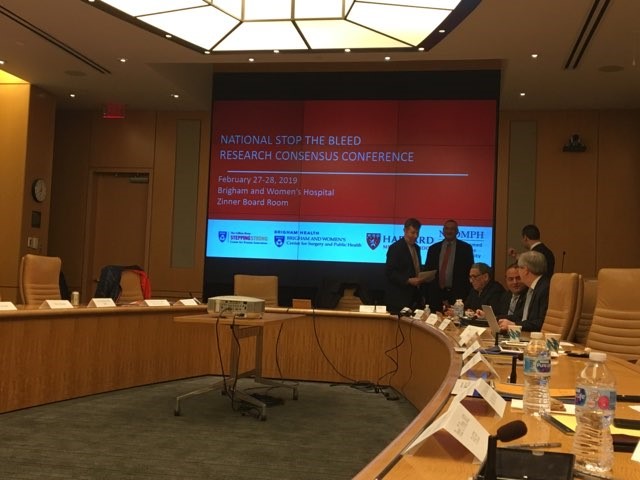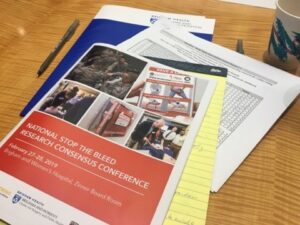Stop the Bleed – Future Research and Prototype Development
KMC Researchers Erik Prytz och Carl-Oscar Jonson were invited to participate in a consensus conference within the Stop the Bleed initiative. Stop the Bleed is an educational concept and effort where US authorities and researchers work on spreading knowledge about how laypersons can stop massive bleedings, e.g. with the aid of a tourniquet. A tourniquet placed around a limb can control massive bleedings when applied the correct way. Massive bleedings require quick first aid actions, and often it is a layperson at an accident scene, who makes the first decisions concerning actions to stop the bleeding. Stop the Bleed aims to enhance preparedness of the public to aid in decision making and taking action in a similar way that CPR today is well-recognized and widely spread knowledge on how to act when faced with cardiac arrest.

Research projects at KMC today develop Stop the Bleed guidelines for Sweden, adjusted to fit the Swedish health care system and context. Erik Prytz och Carl-Oscar Jonson also investigate how laypersons are educated in e.g. estimation of the level of severity of a bleeding.
– During the conference we discussed what the Stop the Bleed-research effort should focus on the coming 10 years. The matters that were discussed were not unfamiliar to us which shows that KMC is on the right track in this field of research, says Erik Prytz.
At the end of the conference the participants agreed on the future direction for Stop the Bleed research by ranking the research questions. The input from the two Swedish researchers was the need of broadening the research effort to other disciplines than purely the medical:
– We work in several projects together with researchers from different areas, like psychology and human factors. What KMC already does for the Stop the Bleed initiative is important to show that a multidisciplinary way of conducting the work pushes the research forwards, says Carl-Oscar Jonson.

Protoype project meeting
The research consensus meeting in Boston was followed by a project meeting in Bethesda outside of Washington for project UtVäG B. The project is in collaboration with NCDMPH (National Center for Disaster Medicine & Public Health) at Uniformed Services University The project investigates how a new type of tourniquets should be developed, in the same way as defibrillators have been developed to be accessible in public spaces. The defibrillators are semi-automated and can guide a layperson how to act when someone suffers cardiac arrest, and in a similar way researchers aim to have tourniquets available in public. This means development work on guidelines that are easy to comprehend and that the tourniquet itself can be applied by anyone.
– We looked at and evaluated a prototype of a tourniquet that the project work has produced. The personal interactions that come with a meeting are always good but this meeting was especially fruitful when having a product that we could gather around and discuss, and re-evaluate, says Erik Prytz.
The project UtVäG B also aims to study and gain knowledge on the challenges that laypersons face in dramatic situations where massive bleedings can occn occur, and what is required of laypersons to act in an appropriate way when performing first aid actions.
In Bethesda, Erik Prytz and Carl-Oscar Jonson also met with representatives for Department of Homeland Security (DHS). Together with the Swedish Contingencies Agency (MSB) future research collaborations and possibilities were discussed. Next up is the HFES (Human Factors and Ergonomics Society) meeting in Seattle in October, where KMC will participate and host a panel discussion together with DHS.